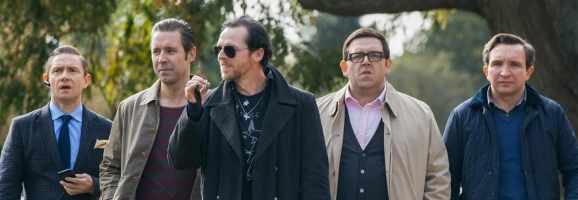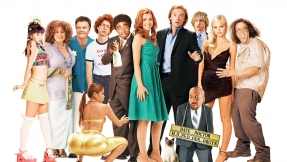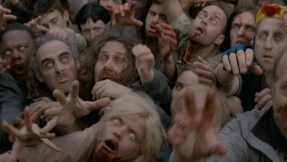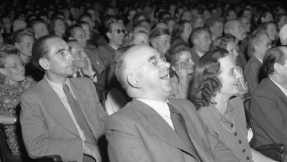Is Parody a Necessary Popular Genre? – The End of the “Three Flavours Cornetto Trilogy”

When a piece of art (be it literature, film or music) is mocked by another piece of art, the latter is a parody of the former. Brendan Gill, The New Yorker film critic, described parody as “homage gone sour”, while Bruce Campbell, an actor who starred in The Evil Dead series defined it simply as “another form of comedy”. The best examples of film parodies find the correct balance between homage and the creation of comedy or making homage funny, rather than blatant displays of recent popular culture.
The latter is of course exemplified by the “Movie” movies, directed and written by Jason Friedberg and Aaron Seltzer and the “Scary Movie” franchise created by Keenan Ivory Wayans, which were predominantly critically panned, while still maintaining an adequate audience to continue the parody. On the other side of the spectrum, there have been the Three Flavours Cornetto Trilogy (Shaun of the Dead, Hot Fuzz, and the long-awaited The World’s End (set for release during July in the U.K. and August in the U.S). All three of the films (directed and written by Edgar Wright, and written by and starring Simon Pegg and Nick Frost) have used a specific popular genre as a springboard for the twisted plot, focusing on being a homage to certain cliches or tropes, rather than forcing as many pop culture references into a 90-minute time-frame. With this, a question must be asked: In today’s cultural smorgasbord, is parody a necessary sub-genre?
First, we must look at genre theory, in which, at least in Christian Metz’s (a French film theorist) hypothesis, parody was the third stage of a film genre, with every genre going through a classic, experimental, parody and deconstruction stage. If we look at the genre of the Western, an example of the classic would be Leone’s The Good, The Bad and the Ugly (1966), the experimental would be Peckinpah’s The Wild Bunch (1969), the parody would be Brook’s Blazing Saddles (1974) and the deconstruction would be the Coen brothers’ No Country for Old Men (2007). With this said, Blazing Saddles is also a classic comedy, it stands alone on its jokes and satire of incompetent leadership, while being structurally supported by its parody of the genre. A parody, especially of such a popular genre as the Western, is based on challenging the usual expectations of the audience expected to watch such a film. For example, in Blazing Saddles, at the end, the two protagonists ride away in a limousine rather than on their horses, as per the usual conclusion to a Western film.
 On the other side of the spectrum, you have the writer-director duo Friedberg and Seltzer, whose films (which include Date Movie, Epic Movie, Meet the Spartans, Disaster Movie) are all as equally bad, except for Vampires Suck, as it actually tries to parody a specific genre or grouping of films (i.e. the Twilight Saga). Interesting anomalies in the film industry, in that they are almost instantly dated as soon as they are released, with popular culture references (it would be more accurate to call them celebrity prostitution, because that is all it really is, riding the wave of a current film or pop culture trend). Therefore, they fall under the spoof genre, like many recent so-called “parody” movies do. Thus, they also transcend Metz’s four stages, they are created and die almost simultaneously, because all of its elements are taken from the present.
On the other side of the spectrum, you have the writer-director duo Friedberg and Seltzer, whose films (which include Date Movie, Epic Movie, Meet the Spartans, Disaster Movie) are all as equally bad, except for Vampires Suck, as it actually tries to parody a specific genre or grouping of films (i.e. the Twilight Saga). Interesting anomalies in the film industry, in that they are almost instantly dated as soon as they are released, with popular culture references (it would be more accurate to call them celebrity prostitution, because that is all it really is, riding the wave of a current film or pop culture trend). Therefore, they fall under the spoof genre, like many recent so-called “parody” movies do. Thus, they also transcend Metz’s four stages, they are created and die almost simultaneously, because all of its elements are taken from the present.
Here, we need to make a distinction between a “movie” and a “film”, wherein the former is created solely to appeal to a specific audience and to create the largest possible profit in the minimal amount of time, regardless of any degradation of artistic integrity and the latter is a piece of art, created with a purpose or underlying message throughout, an extension of humanity, rather than a gratuitous photograph of humanity which these films signify. But, then again, that is the point, Friedberg/Seltzer films are not a parodies of film genre, but rather of popular culture, and should thus, not be evaluated as a film, but rather as a singular mirror to the present media and popular landscape. Looking at their first director/writer outing, the 2006 flick Date Movie, which takes most of its plot inspiration from My Big Fat Greek Wedding and the Meet the Parents/Fockers movies, references Napoleon Dynamite, The Batchelor, the Lord of the Rings films, Jennifer Lopez, Notting Hill, Jerry Maguire, Kill Bill: Vol. 1 & 2, Hitch, Wedding Crashers and King Kong all within a 83 minute running time. In doing such, these films and indeed all parody films should epitomise the idea of laughing at ourselves.
 Conversely, there is the Three Flavours Cornetto Trilogy (2004-13), or some of the best modern parodies out there today, while still remaining self-contained comedies. They possess the different side of the spectrum to “spoof movies”, wherein they pay homage to film, by making the genres they love funny. Shaun of the Dead (2004) parodied zombie films, Hot Fuzz (2007) parodied buddy-cop/action films, while The World’s End (2013), a film supposedly centred around five friends caught up in the middle of an alien invasion during a “pub crawl” through their former home town, will parody science-fiction/alien invasion films. Still, it is necessary to see them as not necessarily purely parodic films, but rather comedies with parodic elements, which is where all the greatest parodies (i.e. Airplane, Blazing Saddles, The Naked Gun) stem from. The trilogy, directed and written by Edgar Wright, is instead known for its running gags, dry English humour, a fast and unique editing pace, great soundtracks and blood… lots of blood.
Conversely, there is the Three Flavours Cornetto Trilogy (2004-13), or some of the best modern parodies out there today, while still remaining self-contained comedies. They possess the different side of the spectrum to “spoof movies”, wherein they pay homage to film, by making the genres they love funny. Shaun of the Dead (2004) parodied zombie films, Hot Fuzz (2007) parodied buddy-cop/action films, while The World’s End (2013), a film supposedly centred around five friends caught up in the middle of an alien invasion during a “pub crawl” through their former home town, will parody science-fiction/alien invasion films. Still, it is necessary to see them as not necessarily purely parodic films, but rather comedies with parodic elements, which is where all the greatest parodies (i.e. Airplane, Blazing Saddles, The Naked Gun) stem from. The trilogy, directed and written by Edgar Wright, is instead known for its running gags, dry English humour, a fast and unique editing pace, great soundtracks and blood… lots of blood.
To put it briefly, they, like all English comedies, get parody right, perfecting the balance between comedy and making fun of other genres. Parody films, at least in terms of “spoof movies”, are not likely to slow down, as straight-to-DVD rip-offs are rife. Looking again at Metz’s theory, another theory should be posited, that “spoof films” is where all good ideas come to die. In terms of the pioneers of this genre, the disgusting duo of Jason Friedberg and Aaron Seltzer, we need to look at them in a way similar to how one would look at a dog who eats their own feces: a mixture of disgust and a degree of respect that they are doing what they think is necessary, regardless of our pleas to stop.
 In answer to whether parody is a necessary popular genre, such a question is like asking: “Is laughing necessary?” or “Is film necessary?” and, consequently, as long as there is art, there will always be a parody of it. Yet, when you see films where 50% of its comedy derive from showing inhuman excretion of bodily fluids and references to other films for no perceivable purpose, a certain needed restraint is evident. Parody films should be funny, otherwise there is no point. But, yet again, there will always be an audience for it. Whether it is necessary or not to further humanity or to create art is irrelevant, because art it is the manifestation of self-parody, the ability to laugh at ourselves. As said by the Russian-American writer, Vladimir Nabokov, “Satire is a lesson, parody is a game.”
In answer to whether parody is a necessary popular genre, such a question is like asking: “Is laughing necessary?” or “Is film necessary?” and, consequently, as long as there is art, there will always be a parody of it. Yet, when you see films where 50% of its comedy derive from showing inhuman excretion of bodily fluids and references to other films for no perceivable purpose, a certain needed restraint is evident. Parody films should be funny, otherwise there is no point. But, yet again, there will always be an audience for it. Whether it is necessary or not to further humanity or to create art is irrelevant, because art it is the manifestation of self-parody, the ability to laugh at ourselves. As said by the Russian-American writer, Vladimir Nabokov, “Satire is a lesson, parody is a game.”
What do you think? Leave a comment.











I enjoyed this post! My only problem. Putting Edgar Wright in the same article as Friedberg and Seltzer is insulting and should be with great care. Do not remind me of that duo again, let alone in the same space as good directors.
Sorry, I apologise for the evident distress I have caused. Just consider yourself lucky that you didn’t have to watch them all in succession for research for this article.
Great article! Beside being brilliant films in and of themselves, I think part of the reason why Shaun of the Dead and Hot Fuzz work so well is because the fact that they are partially homages to their respective genres is so evident. Wright’s, Pegg’s, and Frost’s love of the films that have come before theirs is literally immediately evident to any fellow fan when they realise the music playing over the opening logo of Shaun of the Dead is from Dawn of the Dead. There are hundreds of tiny references like this littered throughout both films – “join us” from the Evil Dead movies in Shaun of the Dead and re-enactments from Point Break in Hot Fuzz etc – and it just shows in the detail how clever and self-aware the films are. I’m really excited to see if they do a similar sort of thing with The World’s End.
I think that SofD and Hot Fuzz work well because they instil a certain amount of nostalgia, but never too much. Yet, I want to see whether Edgar Wright can create a more original work, because I think he is such a talented director. I am so excited to see The World’s End too!
This is a great discussion! It’s true- it’s a love for the subject is what sets films like Shaun of the Dead etc and the Scary Movies apart. S of the D is a homage, never a parody for the sake of parody. Shaun of the Dead is so cleverly crafted it’s not even in the same universe as the Scary Movies. I also don’t get why they’re supposed to be funny.
Building on the self-aware comment from Amelia above – I love how S of the D gives the whole of the plot in the first scene in the plans for a night of drinking after Shaun gets dumped by his gf. I’m also looking forward to the same attention in the script for World’s End. They’re just so much fun to watch!
I just love the “Don’t Stop Me Now”, and the running gun joke in SofD. Can’t wait for “The World’s End” to finally arrive. I’ll be there with a mint choc chip Cornetto 😉
This is an extremely well-written article and you present your argument well. If I do have one criticism, it is your willingness to impose boundaries with your definitions, i.e. film vs. movie, the use of Metz. Scary Movie, for example, is a parody of Scream and earlier horror films, but Scream in certain ways is a parody of even earlier horror films, while also being a horror film itself. Metz doesn’t really account for this complexity. And although you say Scary Movie is a parody of popular culture, so, too, is Shaun of the Dean, simply because film is a part of popular culture, especially our expectations that go with them, including genre tropes and cliches. These are minor details but I respect the article so I thought I’d share them. Great job.
No, I totally agree with everything you’re saying and that what I am saying is completely fallible in terms of film theory. Thankyou for pointing out my mistakes. I guess my mention of “popular culture” is too broad, but rather just forced appearances of celebrities or movie characters just so you can say, “Oh, look, it’s that guy.” Still, thank you for your feedback.
Parodies are usually a sign of when a certain genre has gotten so old that its conventions have become cliche, if not highly recognisable.
Good article, I think parodies like Hot shots and Airplane were awesome, these days most comedy films tend to be crude shock humour.
Parody can also regenerate a genre, i.e. Blazing Saddles, I actually can’t think of many examples, but I still think it has the ability to ignite new forms of a genre. Thank you for your feedback.
Parody is probably the hardest genre to work with. Good parody isn’t just crude, it has to be made by someone who loves the genre enough to understand everything that makes the series so silly. SotD and Hot Fuzz are both great because they are not only great parodies, but they can be considered some of the best movies of the genre they are parodying.
This is a great article, one I enjoyed reading immensely.
I agree; good parody does need a certain level of crudeness, or rather self-awareness that it is being silly, in order for it to work. Thank you!
Fantastic article. I remember reading Metz’ essay in class, your Western examples sum up what he said perfectly. I’m so stoked for The World’s End – Edgar Wright not only has the best understanding of cinematic comedy of any director working today, but he and his writing team genuinely love the films they are sending up, and that truly makes all the difference.
I agree. Thanks!
Firstly, the line ‘we need to look at them in a way similar to how one would look at a dog who eats their own feces’ had me in fits, I wanted to point it out because writing funny things is difficult and you did it!
Also, I absolutely love parody – and if the sheer amount of parodies and parodies of parodies on Youtube/the internet in general is anything to go by I don’t think parody will be done with for a long time, if ever!
So looking forward to The World’s End 😀 (the film, not the concept.)
I’m glad to hear to make you laugh and will try and maintain a respectable funny analogy and insightful analysis ratio in later articles. Me too! Thanks again for the feedback!
Great Article! It Really Helped My Sister With Her Assignment. Your Writing Technique Is Also Very Good.
A modern example of such a parody would be Brad Pitt’s Inglorious Bastards to Tom Cruise’s Valkyrie.
Is parody necessary? In our societies and cultures, yes. In literature and the arts, as a genre, also yes.